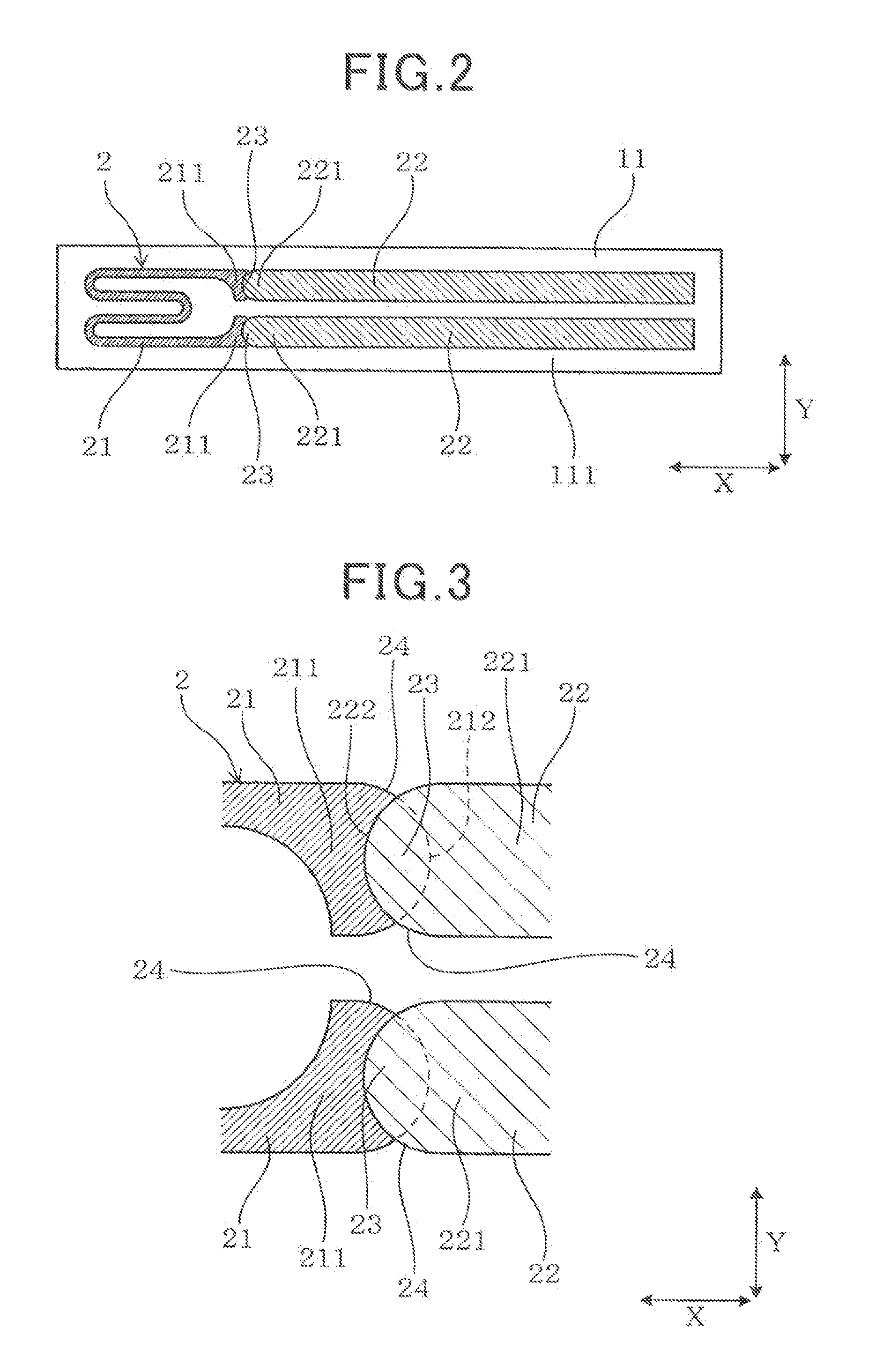Ceramic heater and gas sensor element
- Summary
- Abstract
- Description
- Claims
- Application Information
AI Technical Summary
Benefits of technology
Problems solved by technology
Method used
Image
Examples
example 1
[0061]A ceramic heater and a gas sensor element according to an example 1 are described with reference to the drawings. As shown in FIGS. 1 to 4, a ceramic heater 1 according to the example 1 has a ceramic substrate 11 and a heater pattern 2 formed on the ceramic substrate 11. The heater pattern 2 includes a heating element 21 that generates heat when a current is passed therethrough and a pair of lead portions 22 that conducts electricity to the heating element 21.
[0062]The heating element 21 has a pair of heating connection ends 211 connected to the pair of lead, portions 22, The pair of lead portions 22 has lead connection ends 221 connected to the pair of heating connection ends 211 of the heating element 21. The heating element 21 and the lead portions 22 are connected at joints 23. The joints 23 are formed by overlaying the heating connection ends 211 and the lead connection ends 211.
[0063]The heater pattern 2 formed on the ceramic substrate 11 as viewed from a direction perpe...
example 2
[0106]A ceramic heater 1 according to a second example is described with reference to the FIGS. 7 to 9. In the second and the subsequent examples, the components identical with or similar to those in the first example are given, the same reference numerals for the sake of omitting unnecessary explanation.
[0107]The second example is different from the first example in that the structure of the heating element 21 and the lead portions 22 in the heater pattern 2 has been changed.
[0108]In the example of the heater pattern 2 shown in FIG. 7, the heating connection end 211 of the heating element 21 has the edge 212 having an arc-shaped curve. On the other hand, the lead connection end 221 of the lead portion 22 has the edge 222 which is straight and parallel to the width direction Y.
[0109]In the example of the heater pattern 2 shown in FIG. 8, the heating connection end 211 of the heating element 21 has the edge 212 which is straight and parallel to the width direction Y. On the other han...
example 3
[0113]The ceramic heater 1 according to a third example is described with reference to FIG. 11.
[0114]The third example is different from the first example in that the structure of the heating element 21 and the lead portions 22 in the heater pattern 2 has been changed from the first example.
[0115]As shown in FIG. 11, the heating connection end 211 of the heating element 21 has the edge 212 having a convex part 213 which projects from the edge 212 in the long direction X. The convex part 213 is formed so as to project from substantially the center, in the width direction Y, of the edge 212 of the heating connection end 211.
[0116]The lead connection end 221 of the lead portion 22 has the edge 222 having a convex part 223 which is configured similar to the convex part 213.
[0117]When the convex parts 213, 223 have a length S (S1, S2) in the long direction X and each of the joints 23 excluding the convex parts 213, 223 has a length M in the long direction X, the relation of S=a×M+b is re...
PUM
 Login to View More
Login to View More Abstract
Description
Claims
Application Information
 Login to View More
Login to View More - R&D
- Intellectual Property
- Life Sciences
- Materials
- Tech Scout
- Unparalleled Data Quality
- Higher Quality Content
- 60% Fewer Hallucinations
Browse by: Latest US Patents, China's latest patents, Technical Efficacy Thesaurus, Application Domain, Technology Topic, Popular Technical Reports.
© 2025 PatSnap. All rights reserved.Legal|Privacy policy|Modern Slavery Act Transparency Statement|Sitemap|About US| Contact US: help@patsnap.com



